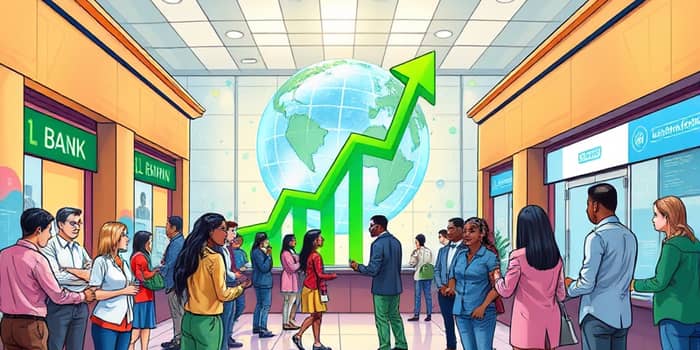
The global financial sector is exhibiting renewed strength as banks pivot from margin expansion to an aggressive lending stance. After a period of cautious balance sheet management and elevated interest rates, institutions are now taking advantage of the expectation of lower rates to drive meaningful loan growth in 2025. This shift signals a wider economic resurgence and highlights the critical role of credit in underpinning future expansion.
Historically, loan growth has fluctuated dramatically, peaking at a record 26.87% in January 1948 and plunging to −8.54% during the depths of the 2010 crisis. The current 2.69% year-over-year increase in total US loans, while modest compared to long-term averages, marks a decisive turning point. By bridging past volatility with present opportunity, banks are laying the foundation for a resilient recovery.
With central banks poised to cut rates by around 70 basis points in the second half of 2025, borrowing costs are set to ease. Previously, banks had focused on expanding margins through high-rate assets to protect profitability. As the rate environment softens, loan growth replaces margin expansion as the primary catalyst for earnings.
United States total loans grew by 2.69% year-over-year in February 2025, up slightly from 2.68% in January. While still below the long-term average of 8.10%, this uptick represents a clear resurgence in credit demand. Lower rates, combined with improved economic sentiment, are encouraging households and businesses to seek financing for consumption, investment, and expansion.
Institutions with assets exceeding $250 billion are at the forefront of this lending rebound. Loan growth projections for these banks climbed to 3.9% in 2025—the highest projected growth rate among peers. Major players like Bank of America credit their performance to AI-driven efficiencies and global commercial teams that streamline credit underwriting and client engagement.
By deploying machine learning algorithms to assess credit risk and automate documentation, large banks have accelerated approval times and expanded into new market segments. This combination of scale and technology is enabling them to capture demand in areas such as renewable energy financing, healthcare projects, and cross-border trade.
Small and regional banks have demonstrated remarkable agility, outpacing larger counterparts in both deposit accumulation and loan originations. Community banks that focus on specialized local markets and personalized service have leveraged deep customer relationships to secure market share.
Their success illustrates how higher relative growth rates amid cautious market sentiment can be achieved through nimble decision-making and tailored product offerings. By marrying localized expertise with efficient digital platforms, community banks are growing portfolios without compromising credit quality.
Commercial real estate (CRE) lending has hit a record high of $3.2 trillion outstanding at the end of 2024. Despite this milestone, CRE’s share of total bank assets remained stable year-over-year. Multifamily loans expanded to $629 billion, while nonfarm nonresidential loans reached $1.8 trillion.
However, the maturity profile poses risks: approximately 25% of CRE maturities in 2025 are office loans, an asset class facing soft office demand and refinancing risk. While multifamily and industrial properties continue to attract investors, concentrations in office space could stress bank balance sheets if borrowers struggle to refinance under less favorable terms.
On the world stage, loan growth forecasts are even more optimistic. Global lending is expected to expand by 6% in 2025, up from 2% in 2024. This rebound coincides with projections that net interest income will return to 3% growth after stagnating last year. Institutions worldwide are investing heavily in digital capabilities, from machine learning for credit scoring to blockchain-based settlement platforms.
Emerging markets are seeing rapid adoption of mobile-first banking models, enabling millions to access credit for the first time. In mature economies, banks are deploying advanced analytics to tailor loan products and pricing, fostering stronger client relationships and more sustainable portfolios.
Despite the optimism, banks remain vigilant. Many began 2025 with sizable liquidity buffers, reflecting a conservative stance amid uncertain demand. Regulators continue to emphasize robust capital ratios and stress-testing to ensure resilience against potential shocks.
Prudent risk management will be essential, particularly in segments like office real estate where refinancing pressures are most pronounced. By combining strong governance frameworks with selective lending practices, banks can safeguard stability while pursuing growth.
As 2025 unfolds, the financial sector’s revival will depend on its ability to adapt and innovate. Lower rates are set to unlock pent-up demand for loans among consumers, small enterprises, and larger corporations. Banks that integrate advanced analytics, seamless digital experiences, and agile credit frameworks will secure competitive advantage.
Ultimately, the current environment presents a unique convergence of supportive rate outlook, robust capital positions, and technological momentum. By balancing ambition with caution and innovation with discipline, financial institutions can transform this rebound into a lasting foundation for prosperity—driving growth, supporting clients, and strengthening economies around the globe.
References













